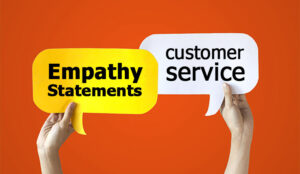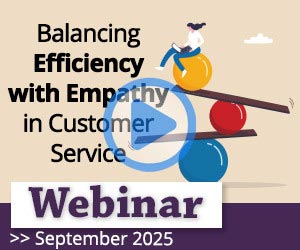With the availability of chatbots, digital options and automated responses, you might expect the workload of call handlers to be low.
However, call centres are as busy as ever. The fact is that people seek answers and options that are specific to their requirements. In times of greatest need, they want to speak to a real person.
As such, customer service depends on empathic call handlers, so how do we develop empathy? Helen Pettifer, a specialist in the fair treatment of vulnerable customers, explains all.
What Is Empathy?
Empathy is a connection with the feelings expressed by another. It is a social skill and an instinctive response to another person’s emotions.
Empathy means that you don’t have to be in their shoes to understand their perspective and how they might be impacted by life situations.
Empathy is part of what makes us human. AI and machines can be programmed to provide comprehensive answers and generic services, but they lack that human connection. This is why many customers prefer to speak to a real person.
How to Develop Empathy as a Skill With Your Team
We all have differing levels of empathy. The good news is that this skill can be developed.
Here are some practical examples and training exercises to help develop empathy skills with your teams:
Active Listening Workshops
Organize workshops or training sessions focused on active listening techniques.
Encourage participants to actively listen to their team members without interrupting and to demonstrate understanding through verbal and non-verbal cues.
Case Study Discussions
Present case studies or real-life customer interactions for group discussion.
Encourage team members to identify moments where empathy could have been better demonstrated and brainstorm alternative responses.
Customer Persona Exercises
Provide team members with fictional customer personas representing different demographics and backgrounds.
Have them analyse each persona’s needs, emotions, and potential challenges to develop empathy for diverse customer experiences. For example, with a ’More Than Meets the Eye’ training game.
For more on customer personas, check out our video article: Using Personas in Customer Journey Mapping
Empathy Mapping
Use empathy mapping techniques to visually represent the thoughts, feelings, and needs of customers during different stages of the interaction process.
This can help team members better understand and empathize with customer experiences.
1-2-1 Feedback and Coaching Sessions
Provide individualized feedback and coaching to team members based on their empathy skills.
Listen to recorded calls together and discuss areas for improvement, highlighting moments of effective empathy.
Looking to coach empathy? Read our article: How to Coach Empathy in the Contact Centre – With Three Training Exercises
Encourage Self-Care
Promote self-care practices among team members to help them manage stress and prevent burnout.
Encourage breaks, offer resources for stress management, and foster a supportive work environment.
You should also be aware of the danger of vicarious trauma. For more information, read our article: Introduction to… Vicarious Trauma in the Contact Centre
Seek Out Fresh Perspectives and Challenge Conscious Bias
Encourage all team members to spend time with people from different backgrounds, age groups, cultures, etc.
Be curious about their experiences, challenges, perspectives. This can be within the work environment or outside.
They can listen to podcasts on subjects they’re not familiar with. Volunteer with organizations that support people experiencing different life events and health conditions. Challenge conscious biases by learning more about other people.
Lead by Example
Model empathetic behaviour in all interactions with team members. Show genuine concern for their wellbeing, listen attentively to their issues, and offer support and guidance when needed.
Explain What Empathy Is NOT
It can also help to explain to your team what empathy is NOT!
Empathy is not a judgement about another person’s situation. It’s not sympathy. It isn’t about your feelings about a person and their situation.
Instead, it is an understanding of what they might need or why they might behave in a certain way. You might not agree with what they think, say or do, but you can comprehend it.
Equally, empathy is not assuming that what you would do in a certain situation is right or appropriate for someone else. You have to set aside your opinions and actively listen.
The more information you gather from the other person, the better able you are to support them towards their desired outcome. What works for one person may not be right for another in similar circumstances.
Here are some quotes to help highlight the differences:
Sympathy vs. Empathy
- “That’s awful, I feel so sorry for you. I’d never cope if that happened to me.”
- “That sounds difficult but you’re doing an amazing job. How would you like me to help?”
Judgement vs. Empathy
- “Why did you do that? You should have …”
- “You decided that was the right decision at the time. How did it work out?”
Assumption vs. Empathy
- “What you need is … ”
- “I have a few options, see if you think one of these is worth trying.”
For an action plan for empathizing with customers, read our article: An Action Plan for Customer Empathy
Why Empathy Is an Essential Skill for Call Handlers
Many customers are experiencing financial difficulties, physical and mental health conditions or life situations that make it difficult to cope.
This means that call handlers are regularly responding to complex and emotional disclosures.
They can’t just plough on with the set procedure when the customer shares a disclosure or is emotional during a call.
This is where empathy plays an important role. It informs when it is appropriate to pause the script and actively listen to what’s being said. It is responding with respect and compassion.
“Thank you for sharing that with me. That does sound like you are facing difficult times. How has this impacted you?”
“I appreciate you telling me about your situation. Unfortunately, this is not something that we can help with. However, I know that … can. Would you like me to book an appointment for you or send you a link to their website?”
“Thank you for being so honest. Now that I understand your circumstances, I can advise you on a few options which I believe will be helpful.”
Empathy can also help defuse anger and accusations. Our instinct is to respond to anger defensively.
However, with empathy, we recognize that this is not a personal attack, but an expression of frustration with the situation. As a result, empathy enables us to remain calm and focused.
“I accept that you are frustrated, but I am here to help. I will stay on the call until the issue is resolved, so let’s start by…”
“I can tell this has been a difficult day. I need to ask a couple of questions to sort this out. Let me know when you are ready.”
The ability of call handlers to show empathy is dependent on whether they are adequately equipped. In addition to training, it depends on having scope and time to go off script and respond appropriately.

It means being kept up to speed with internal and external services that can help them give customers options.
It also relies on them being able to seek support following difficult conversations or personal circumstances, so they remain resilient. Are you providing what they need?
Written by: Helen Pettifer, Director of Helen Pettifer Training Ltd and a specialist in the fair treatment of vulnerable customers.
If you are looking for more information on developing and showing empathy in the contact centre, read these articles next:
- Empathy Statements for Customer Service With Examples
- 26 Great Techniques for Showing Real Empathy in Customer Service
- Start Using AER Statements
Author: Helen Pettifer
Reviewed by: Xander Freeman
Published On: 17th Apr 2024 - Last modified: 7th Jan 2026
Read more about - Skills, Editor's Picks, Emotion, Empathy, Handling Customers, Helen Pettifer, Skill Development, Soft Skills, Top Story







































